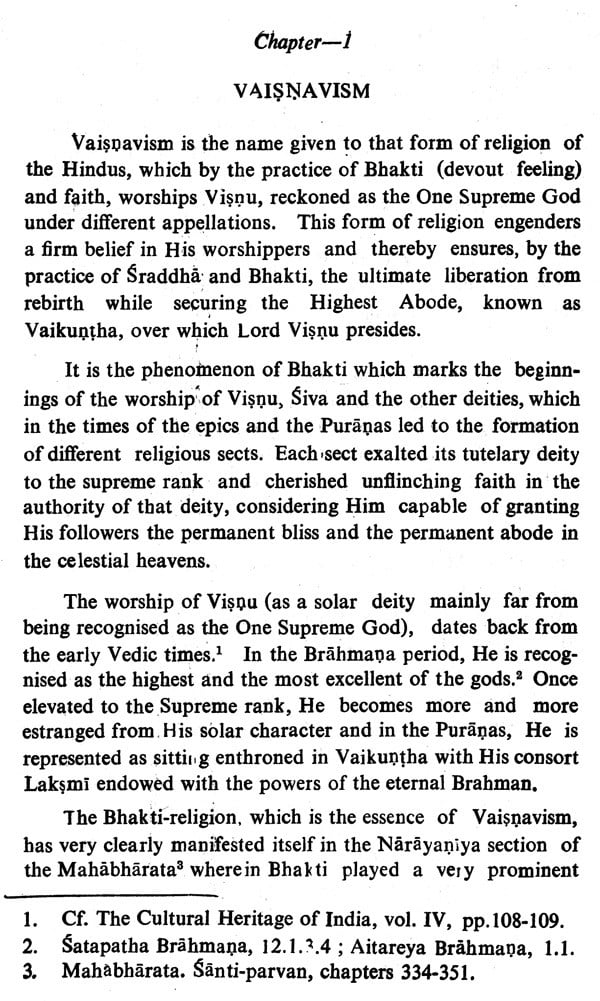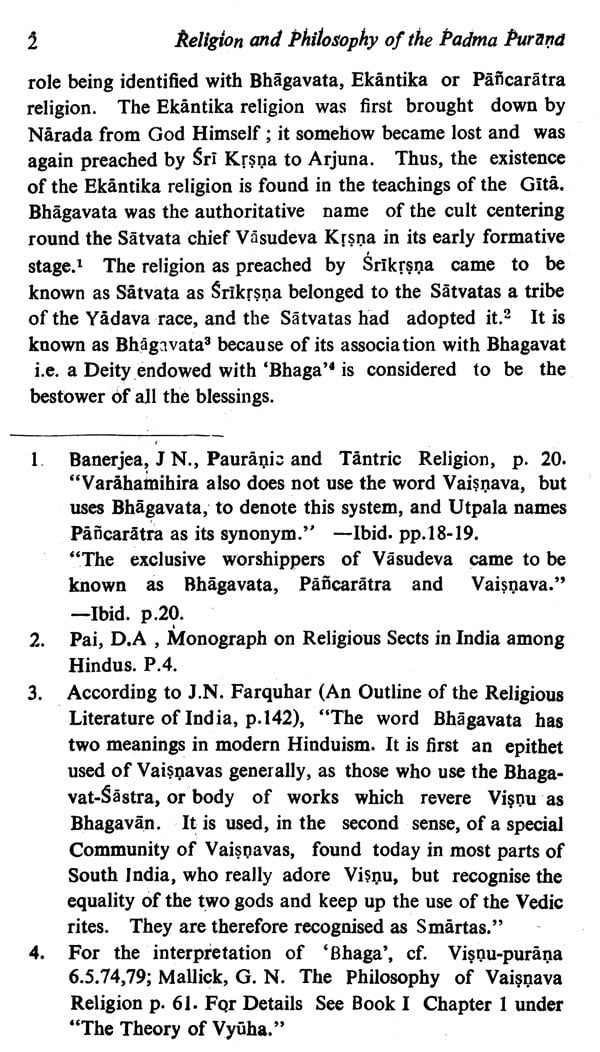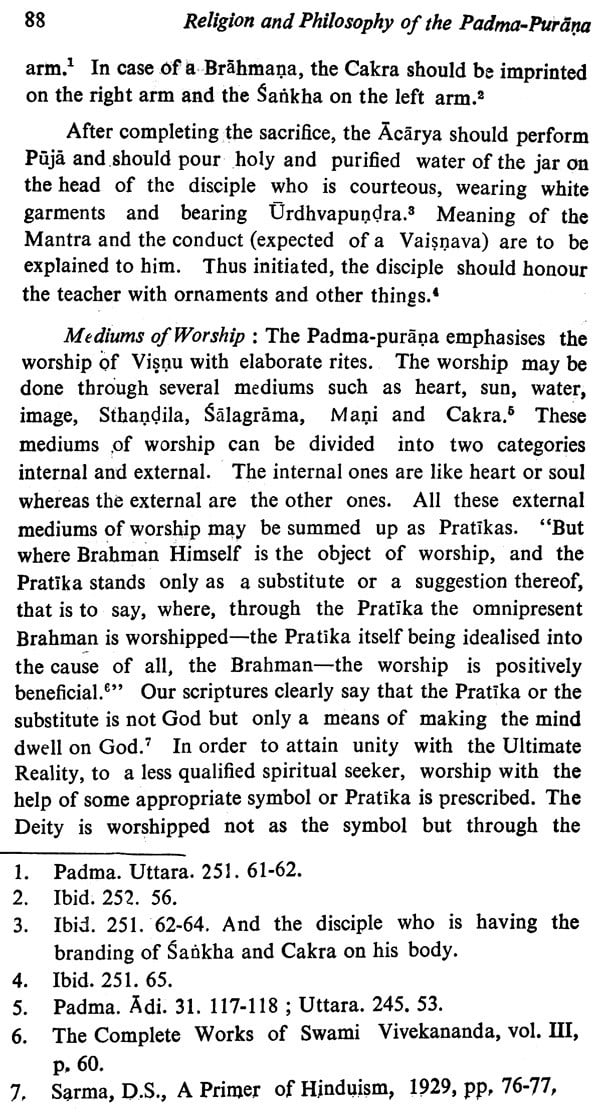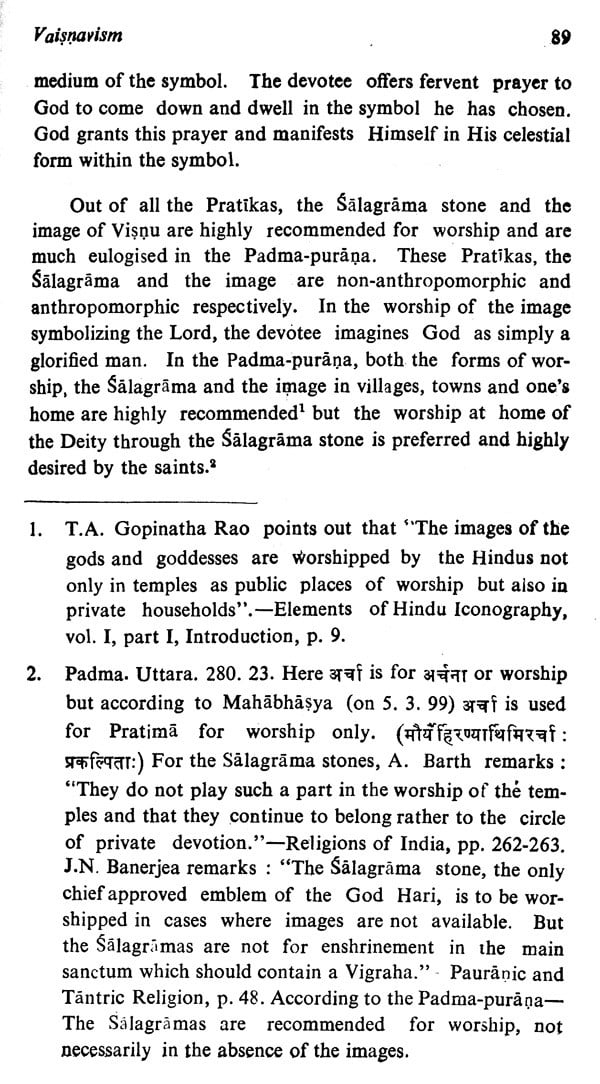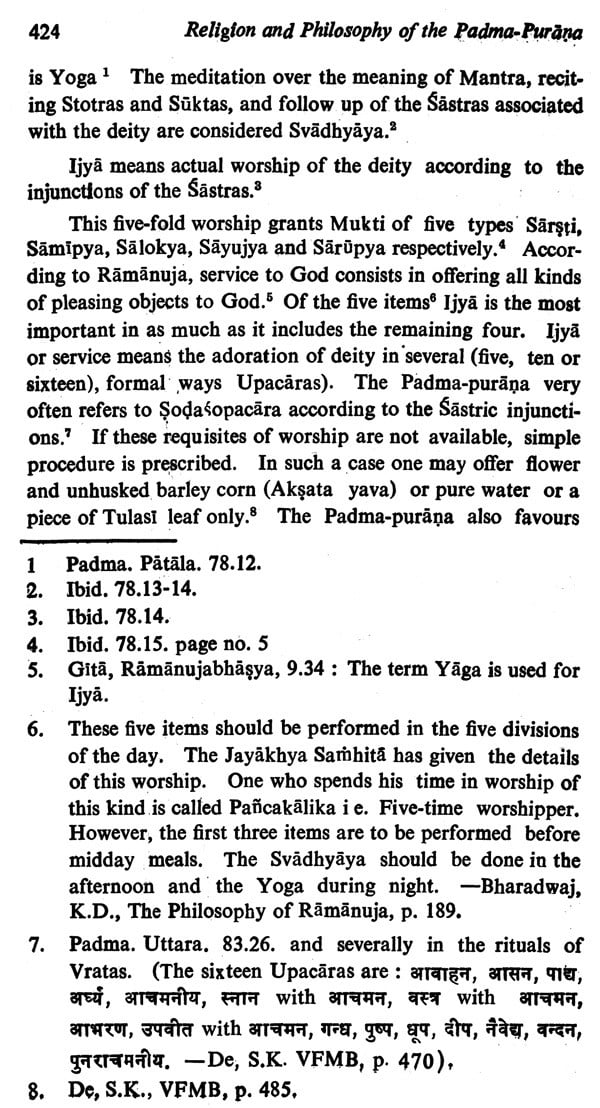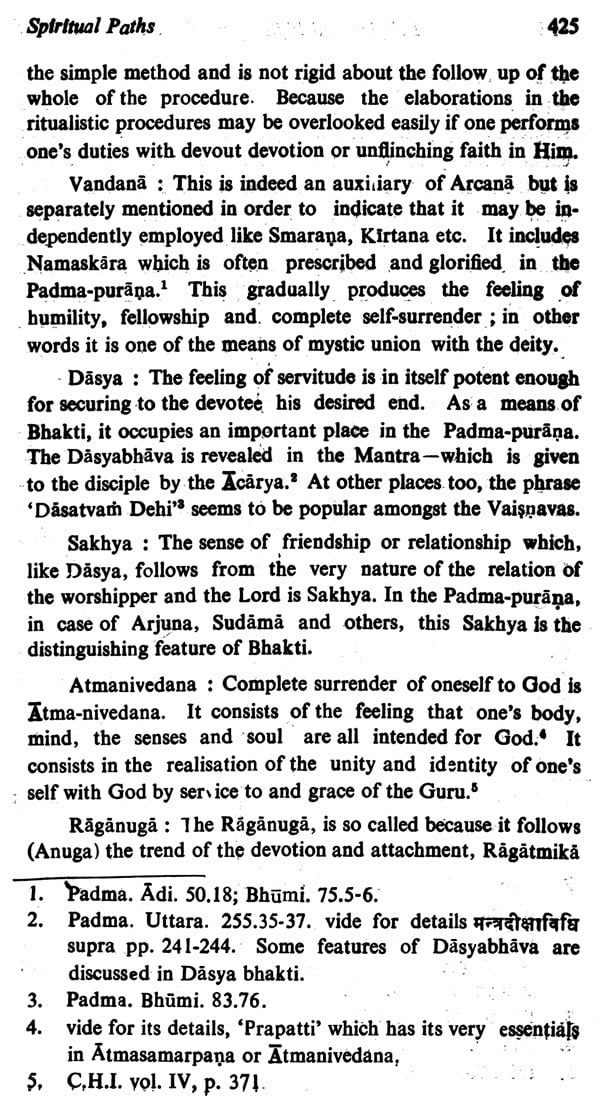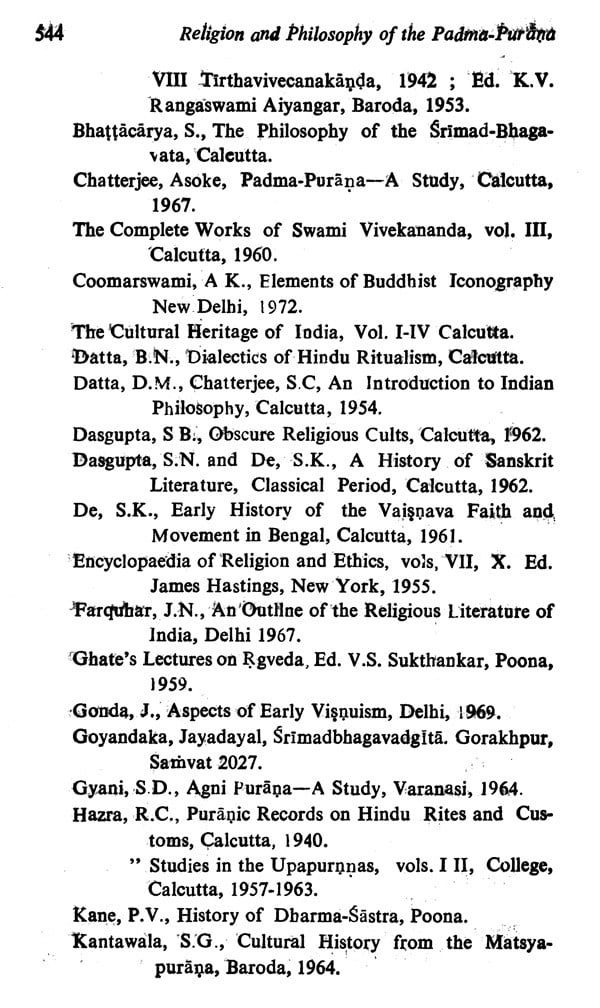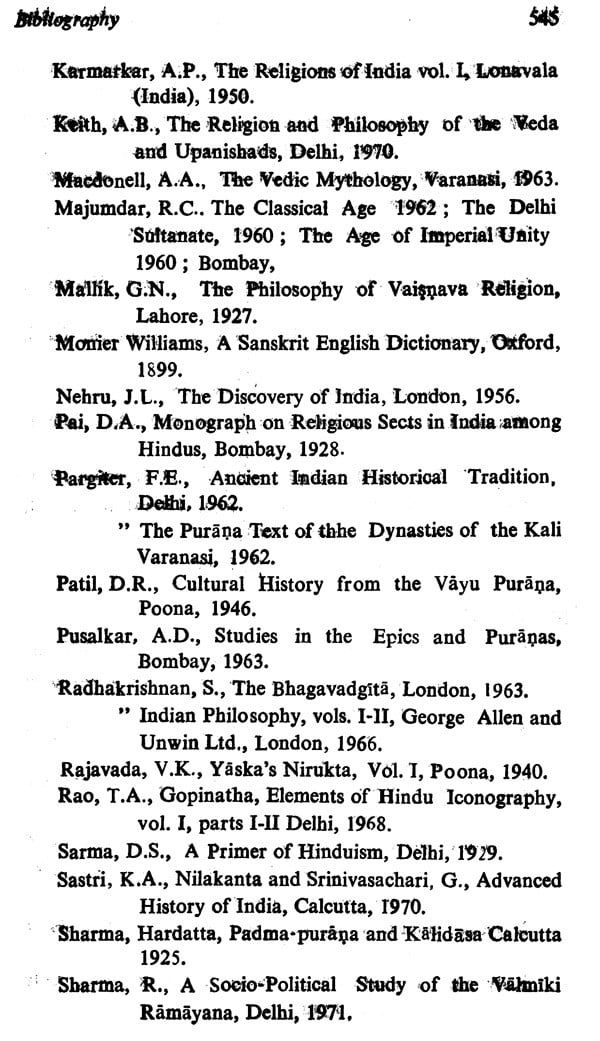
Religion and Philosophy of the Padma - Purana (An Old Book)
Book Specification
| Item Code: | IDI075 |
| Author: | Dr. Sharda Arya |
| Publisher: | Nag Publisher |
| Language: | English |
| Edition: | 1988 |
| ISBN: | 8170811902 |
| Pages: | 616 |
| Cover: | Hardcover |
| Other Details | 9 .6"X 8.6" |
| Weight | 730 gm |
Book Description
In Delhi University I enrolled myself as a ph. D. Student for the " Critical study of the Padma-purana with special reference to Religious Rites and Ceremonies". An intensive study of the text brought to surface so much material that it was difficult to contain it all within the narrow framework provided by the topic. Therefore, it became imperative to widen the scope of the topic. As the investigations progressed, it was discovered that one cannot limit oneself purely to what strictly came under religion without taking note of the philosophy which formed the background of the religious concepts and practices found in the Padma-purana. And hence the title "Religion and Philosophy of the Padma-purana".
A voluminous work, as the Padma-purana is, where every idea and doctrine is presented through challenging task. The text of the Purana itself is available in two distinct recessions- North Indian and South Indian. I have utilized the south Indian recession published by the Anandasrama Press, Pune. No English translation of the Padma-purana is available so for. There is one abridged Hindi translation published as Kalyana Samksipta Padma-Purananka-Versha 19 Anka 1 by Gita press, Gorapura, October 1944.
The purana contaning 48, 452 verses in 6 khandas is so big that the study of the text in itself was a very strenuous task. Nevertheless the knowledge earned in the process was reward of immeasurable value. I feel immensely happy to present this work through this published volumes. I have tried to do justice to the subject to the best of my ability and capacity.
The study of the Padma-purana is of great interest as well as importance since it provides a clear understanding of the development of religious and philosophical ideas ranging over a period of almost ten centuries. It is necessary to point out here that while dealing with the time and contents of the purana some of the facts, arguments and conclusions arrived at are the same as already provided by the stalwarts in the field Dr. Hazra and Dr. Asoke Chatterjee in their well-known books named "Puranic records on Hindu Rites and Customs" and " Padma purana a study" respectively. And also I have freely utilized the ephoch making works of Dr. Siddheshwar Bhattacharya, Dr. S. G. Kantawala and Late Dr. P. V. Kane as they were extremely useful for the study of the present, subject. I owe deep gratitude to all these scholars.
From the Jacket
In her book entitle " Religion and Philosophy of the Padma-purana", Dr. Sharda Arya has discussed the name, title, place and two fold character of the Padma-purana. The specific rituals connected with each one of them and the religion of the masses such as Tirtha, Vrata, Dana and Stotra have been discussed in separate chapters. Some space has also been given to the Navagrahapuja. The philosophical principles underlying these sects like the concepts of God, Atman, the world and its theories of creation along with the concept of Moksa and the spiritual Paths (mainly Bhakti) leading to it and the doctrines of Karman and purnarjanman have also dealt with at length. Therefore the whole matter has been divided into two Books: I- Religion and II-Philosophy. The Book I is further divided into two Parts (A) Religious sects and (B) Religion in common practice. At the end she has given comprehensive lists of Vratas, Utsavas and deep study would be extremely useful for the research oreintalists.
Dr. Sharda Arya is a senior Lecturer in Daulat Ram College, Delhi University. She has been teaching Sanskrit for more than 20 years now she holds a Ph. D. degree from Delhi University and she has also been U. G. C. Fellow.
| Foreword | v-vi | |
| Preface | vii-viii | |
| Introduction | I-Lxii | |
| Importance of the Puranas: the term 'Purana' and its antiquity: Characteristics of the Puranas, Number of the Puranas and Place of the Padmapurana: text of the Padma purana -two divisions (Twofold character- Brahmaite and Vaisnative): Date of the Padma purana: Scheme of the present work. | ||
| Part A -Religious Sects | ||
| Introductory | i-vii | |
| Chapter 1 : Vaisnavism | 1-101 | |
| General Background : Vaisnavism in the Padmapurana: Visnu: Vasudeva: Narayana: Vasudeva-Krsna: Rama: Description etc.: Other Appellations: Consort :Abode : Theory of Avatara : Purpose and Nature of the Avataras: Number of the Avataras- Matsya Kurma varaha Nrsimha, Vamana, Parasurama, Rama Krsna Buddha and Kalkin: Theory of Vyuha. Vaisnva-Rituals: Importance of Rituals in Religion: Characteristics of a Vaisnava: Modes of Worship to be practiced by a Vaisnava: Repeating mantras: Dvadasadha-Sudhi: Pancasamskara Ritual: Mediums of worship- Salagrama- worship, Image-worship. | ||
| Chapter 2: Saivism | 102-135 | |
| General Background; Saivism in the Padmapurana: Rudra-Siva : Rudra as an Agent of Creation : Eight Forms: Rudras: Epithets: Description etc. : His Family : Skanda: Ganesa: Ganas of Siva- Nandi, Kirttimukha. Saiva- Rituals: Importence of Siva's worship: Rudraksamala: Mantra: Use of Bhasman: Siva- Linga Form of Worship. | ||
| Chapter 3: Ganesa and the Ganapatya Sect | 136-141 | |
| General Background: Ganesa in the Padmapurana- His Origin Names of Ganesa. Worship of Ganesa. | ||
| Chapter 4: Saktism | 142-160 | |
| General Background: Sakti in the Padmapurana: Twofold Nature of Sakti- Benevolent and Malevolent : Sakti associated with Siva and Visnu: Matrkas: Yoginis: Saivi Goddesses- Ksemankari, Sivaduti, Vindhyesavri (Nisa) , Candi (Camunda, Candika) Kalyani, Jambhaka, Gauri (Uma, Parvati): Vaisnavi Goddesses- Kamaksi, Kotaraksi, Narayani. Sakta Rituals | ||
| Chapter 5: Brahmaism | 161-172 | |
| General Background: Brahma in the Padmapurana: Description etc.: Abode. Brahma - Rituals Nature of Brahma- Worship in the Padma -purana: Tapas, Meditions etc.: Japa of the Gayatri Mantra: Diksa: Rathayatra-mahotsava: Image- Worship: Vrata, Upavasa etc. | ||
| Chapter 6: Saura-Cult | 173-181 | |
| General Background: Saura-Cult in the Padma-purana: Dominance of Surya: Description etc.: Twelve Names of Surya. Saura- Rituals: Mantra, Vrata, etc.: Lotus as symbol of Sun- worship: Worship of Sun's Image. | ||
| Worship of the Navagrahas in Brahmanical Ritualism | 182-190 | |
| General Background: Worship of Surya, Candra, Bhauma, Budha, Brhaspati, Sukra, Sani, Rahu, and Ketu. | ||
| Chapter 7: Some heretical or Non-Brahmanical Sects | 191-192 | |
| Buddhism: Jainism. | ||
| Part B- Realigion in Common Practice | ||
| Introductory | 195-196 | |
| Chapter 8: Tirtha- Yatra | 197-212 | |
| General Background: Meaning of the word 'Tirtha', Concept of Tirtha in the Padma-purana : number and Glory of Tirthas: Preliminaries to Tirthayatra: Mode of Travel: Commendable practices at Tirthas: Natural Death or Suicide. | ||
| Chapter 9: Vratas | 213-248 | |
| General Background: Meaning of the term 'Vrata': Concept of Vrata in the Padma-purana: Essentials of Vrata -Mental and Physical: Number and glory of Vratas in the Padma-purana: Time for Commencement and duration: Samkalpa: Bath: Worship of Guru : Worship of a particular Divinity: Rituals of worship: Mandapas: sthandila: Kumbha: Homa: Jagara: Daksina and Dana : Parana or Parana ; Udyapana: Tantric element found in Vratas. | ||
| Chapter 10: Danas | 249-297 | |
| General Background : Concept of Dana in the Padma-purana: Constituents of Dana- Datr Sraddha, Patra, Deya, time of Dana and Place: Procedure of Dana ritual: Glory of Dana: Some Important Gifts in the Padma-purana- Annadana, Abhayadana, Kanyadana, Grhadana, Vidyadana, Tulapurusadana, Dhenudana, Pravatadana, abrahmandadana, Bhumidana, Devaprasada, Padaparopana, Paniyadana, Setubandha Gosirahthapana, Gopracara | ||
| Chapter 11: Stotras | 298-305 | |
| General Background: Stotras in the Padma-purana: Importance of the Stotras: Theme of the Stotras: Poetical excellence | ||
| Introductory | 309-310 | |
| Chapter 1 : God | 311-316 | |
| Puranic Concept of God: Influence of Samkara and Ramanuja | ||
| Chapter 2 : The Atman | 317-321 | |
| Concept of the Atman: Influence of Samkara and Ramanuja | ||
| Chapter 3: The World and the Theories of Creation | 322-351 | |
| (a) | The World : God and the World views of Samkara and Ramanuja on the Point. | |
| (b) | The Theories of Creation : Cosmic Egg Theory: Lotus Theory: Sacrifice Theory: Yajna-Varaha-Theory : Ninefold Creation of Brahma: Twofold Creation - Manasi Srsti and Maithuni-Srsti | |
| Chapter 4: Doctrines of Karman and Punarjanman | 352-363 | |
| Concept of Karman and Punarjanman: Three types of Karmans: Concept of Fate: Concept of Papa and Punya: Echatalogy. | ||
| Chapter 5: Spiritual Paths | 364-438 | |
| General Background -Concept of Yajana: Yoga: Jnana-Yoga: Karma- Yoga: Bhakti Yoga-Bhakti as Parama Dharma, Nature of Bhakti Bhakti and Preman Bhakti and Jnana Different attitudes of mind (Karma, Krodha, Dvesa, Bhaya, Sama, Dasya, Sakhya, Vatsalya), Bhaktirasa Bhakti and Karman Doctrine of Prapatti, Doctrine of Grace Kinds of Bhakti (Vaidhi and Raganuga), Spiritual and Ethical discipline of Bhakti Supreme efficacy of Bhakti | ||
| Chapter 6: Mukti | 439-449 | |
| Concept of Mukti in the Padma-purana: Kaivalya (Samkara's Influence) : Forms of Mukti : Five Stages of Mukti : Mukti and Bhakti: Divine Kingdom (Ramanuja's Influence). | ||
| Conclusion | 450 | |
| Appendix I : List of Vratas and Utsavas | 463 | |
| Appendix II : List of Stotras | 520 | |
| Bibliography | 540 |
